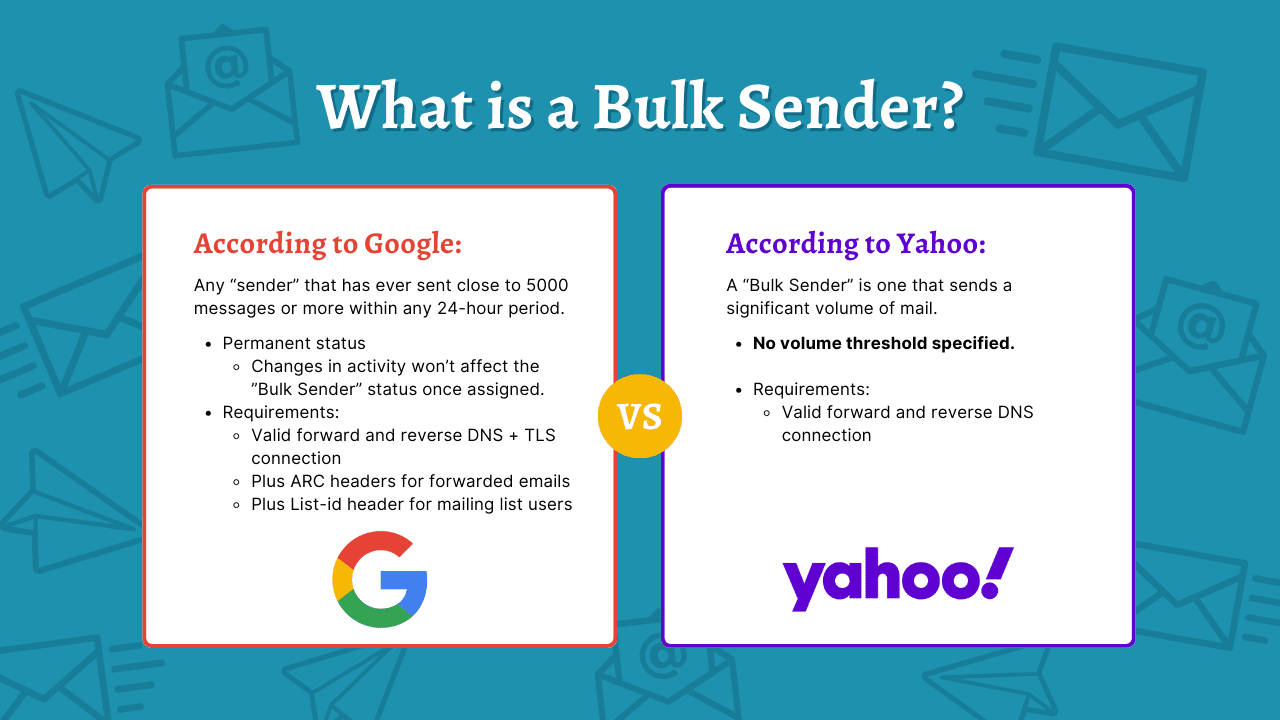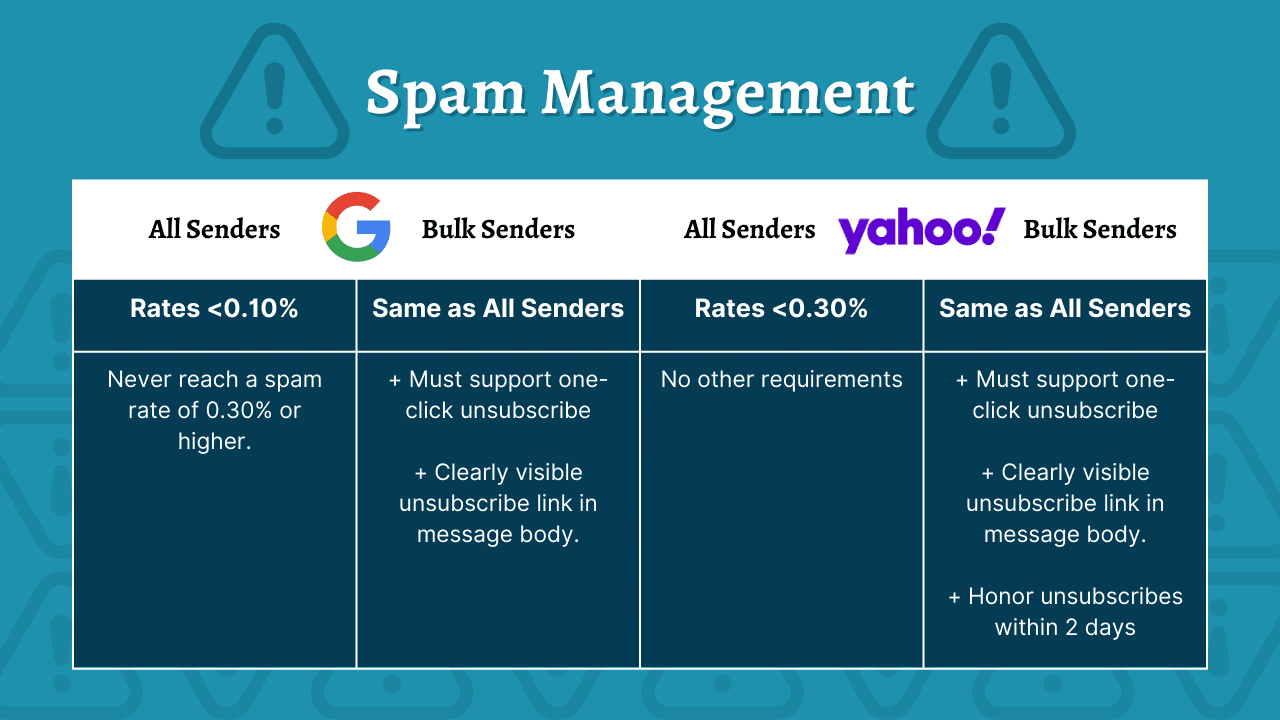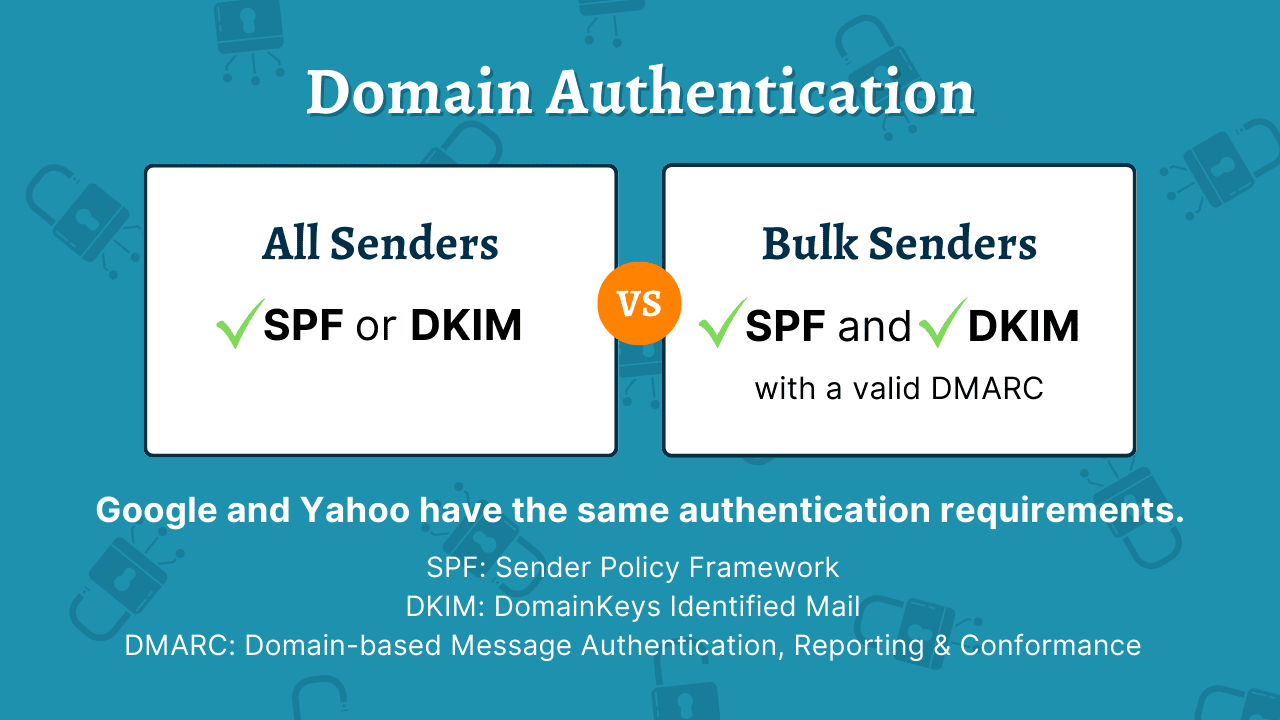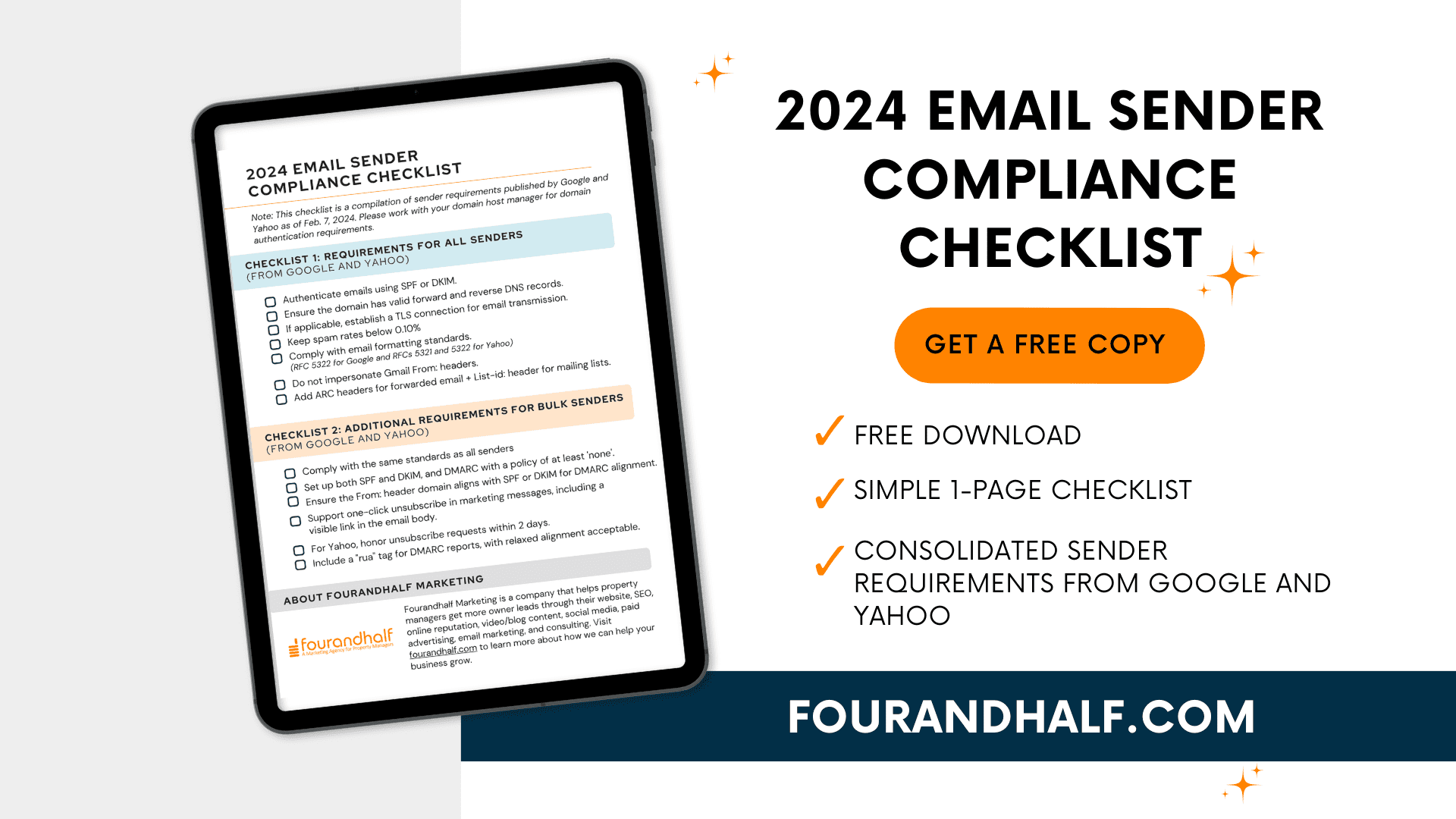Email remains a cornerstone of business communication, and with large providers like Gmail and Yahoo updating their sender requirements, it’s crucial for property managers, small business owners, and real estate professionals to stay informed. In 2024, sender reputation and email deliverability will be more important than ever for maintaining contact with clients and prospects.
Understanding the New Sender Requirements
Gmail and Yahoo are making significant updates to their sender requirements to improve email security, combat spam, and ensure that legitimate emails reach their intended recipients. Gmail Sender Requirements and Yahoo Mail Changes affect how businesses need to authenticate their email communications to prevent them from being filtered as spam or rejected outright.
These changes will not only impact Email Deliverability but will require businesses to be proactive in understanding and adhering to the new policies. Let’s explore what these mean for your property management or real estate business.
What is a “Bulk Sender”, and how do I know if I am one?
Now, you may have read some articles that throw around the term “bulk senders” and how the Google and Yahoo policy changes mostly impact them. But what is a “bulk sender” anyway? Well, it depends who you ask.
Google defines a “bulk sender” as any sender domain/ entity that has ever sent close to or exceeding 5,000 emails to Gmail users within any 24-hour period. In comparison, Yahoo defines it as any entity that sends a significant volume of mail. And yes, they refuse to specify what exactly they consider a “significant” amount.

It’s interesting to note that being tagged as a “bulk sender” with Google is permanent, and you only need to hit the criteria once (yes, once) to be labeled as such. And because it’s permanent, changing your email activity now or in the future will not affect that label.
Note that this email threshold includes all messages sent from the same overarching domain. This means that if your property management or real estate business uses a shared email domain, and multiple individuals send emails from that domain, the total number of emails sent will be counted towards the threshold. If that was a bit confusing, we don’t blame you.
Let’s look at an example to clarify what that means:
Suppose your domain is PropertyManager.com, and you have multiple email addresses under that domain:
- info@propertymanager.com – used for inquiries
- marketing@propertymanager.com – used to send out marketing emails to your mailing list
- sales@propertymanager.com – sales correspondences
- john.doe@propertymanager.com – business email
- jane.doe@propertymanager.com – business emails
- notifications@propertymanager.com – notification emails to owners, tenants, vendors
If there was ever a time when the total number of emails sent from all of the above email addresses approached 5,000 within a 24-hour period, then Google would have labeled your domain as a “bulk sender.” They don’t just count emails that are sent through your email marketing software. They count all emails sent from your sender domain.
Understanding this distinction is important because it helps you identify whether your business is considered a “bulk sender” and therefore, subject to Gmail and Yahoo’s stricter sender requirements. This will ultimately impact how your emails are delivered to recipients, so it’s crucial to be aware of this classification.
Requirements for All Senders vs. Bulk Senders
If you breathed a sigh of relief because you determined that your property management company or small business is not a “bulk sender”, sorry to break your bubble. That doesn’t necessarily mean that you are completely off the hook either.
Google and Yahoo have updated their email sender guidelines to list a minimum set of requirements for all senders, not just “bulk senders.” We reviewed both sets of guidelines in great detail and summarized them in this table:
| YAHOO | ||||
|---|---|---|---|---|
| Criteria | Google (All Senders) | Google (Bulk Senders) | Yahoo (All Senders) | Yahoo (Bulk Senders) |
| Definition | Any entity that sends email to personal Gmail accounts. A personal Gmail account is an account that ends in @gmail.com or @googlemail.com. | Any “sender” that has ever sent close to 5000 messages or more within any 24-hour period. Bulk sender status is permanent. Changes in activity will not affect the permanent “Bulk Sender” status once assigned. | A “sender” is viewed at the authenticated domain or From header domain level. However, Yahoo will use all of the information available (content, IP, etc.) to review sender compliance. | A “Bulk Sender” is one that sends a significant volume of mail. Yahoo will not specify a volume threshold. |
| Authentication | SPF or DKIM | Both SPF and DKIM, plus DMARC with at least “p=none” | SPF or DKIM | Both SPF and DKIM, DMARC with “p=none” |
| DNS Records | Valid forward and reverse DNS records | Same as all senders | Valid forward and reverse DNS records | Same as all senders |
| TLS Connection | Required | Required | Not specifically mentioned | Not specifically mentioned |
| Spam Rates | Keep below 0.10%, avoid reaching 0.30% | Same as all senders | Keep below 0.3% | Keep below 0.3%, monitor closely |
| Email Formatting | Same as all senders | Same as all senders | Comply with RFCs 5321 and 5322 | Same as all senders |
| Impersonation | Do not impersonate Gmail From: headers | Same as all senders | Not specifically mentioned | Not specifically mentioned |
| Forwarding Emails | Add ARC headers (forwarded mail) and List-id: header (mailing lists) | Same as all senders | Not specifically mentioned | Not specifically mentioned |
| DMARC Alignment | Not required for all senders | Domain in From: header must align with either SPF domain or DKIM domain | Not required for all senders | Domain in From: header must align with either SPF domain or DKIM domain |
| Unsubscribe Mechanism | Not specified for all senders | Support one-click unsubscribe, include visible link in body | Not specified for all senders | Support one-click unsubscribe (RFC 8058 recommended; mail-to: method acceptable), include visible link in body, honor unsubscribed within 2 days |
If you want to get more details, here is Google’s updated sender requirements as well as Yahoo’s sender FAQs page.
We created a simple checklist that you can download for free to help you navigate all these requirements: download the checklist here.
What Types of Emails Are Affected by the New Sender Requirements?
Technically, this affects all emails being sent from your domain. Everything from your small company’s newsletters, promotional campaigns, business email exchanges, and even notification emails that property management companies send to current tenants and owners.
This is because the new sender requirements are connected to your sender reputation and deliverability. We’ll cover sender reputation in more detail later in this blog.
Spam Management for Enhanced Email Deliverability
Mastering spam management is not only about protecting your recipients from unwanted messages but also about safeguarding your sender reputation and achieving high email deliverability rates. As a property management or real estate professional, it’s important to understand spam complaint rates and how they can significantly impact your email marketing campaigns.
Spam complaint rates are a critical metric indicating the number of recipients who have marked your emails as spam. Maintaining a low spam complaint rate is essential; exceedingly high rates are a red flag to email providers, leading to possible blacklisting or penalization in email deliverability.
Here are tips on how you can skillfully minimize spam complaint rates:
- Start with a clean slate: Only email those who have explicitly opted in or shown genuine interest in your property management offerings.
- Clarity is key: Use transparent subject lines that reflect the content of your email.
- Easy exits: Include a straightforward unsubscribe option in every email.
- Tidy up: Regularly clean your list to remove unengaged subscribers.
- Strike a balance: Be persistent in your communication but avoid becoming a nuisance.
- Personalize: Tailor your content with relevant rental market or real estate market updates and insights to show clients you understand and value their unique needs. Personalizing sends a strong message: you value them as people, and you’re not just sending out mass, irrelevant communication.
By following these steps, you’ll maintain a strong presence in your clients’ inboxes, providing value without overwhelming them. It’s a fine balance between persistence and perception – the goal is to maintain visibility without becoming an annoyance.

Remember, in the competitive arena of property management and real estate, those who respect and effectively communicate with their audience will ultimately gain the upper hand.
However, monitoring spam complaint rates is just one aspect of spam management. Now, let’s look at spam management on the domain side of things.
Understanding Domain Authentication in Email Marketing
Domain authentication is a fundamental component of your email marketing strategy, integral to establishing trust with email service providers and your clients alike. This process involves setting up various records—SPF, DKIM, and DMARC—to verify that you are a legitimate sender, effectively reducing the chances of your emails being flagged as spam.

Making Sense of SPF, DKIM, and DMARC
Building strong and secure communication channels is pivotal for the success of property management companies, real estate professionals, and any small business. To give you a better sense of what these 3 acronyms mean, here’s an analogy:
Imagine if every email was a postcard traveling through a bustling city — SPF (Sender Policy Framework) is like a special seal that tells the email postman, “Yes, this message truly comes from the address written on it.” It’s a way to verify that the sender is who they say they are.
Then, DKIM (DomainKeys Identified Mail) acts like a secret handshake between the sender and the receiver. It ensures that the content of the email remains unchanged from the point it was sent to when it lands in the inbox. Think of it as a wax seal on a letter, guaranteeing that nobody tampered with it during its journey.
Lastly, DMARC (Domain-based Message Authentication, Reporting & Conformance) is the guardian that uses the combined power of SPF and DKIM to give a strong message to the email world: “If the email doesn’t have my special seal or secret handshake, be extra cautious before delivering it.” It’s an additional layer of protection that tells email providers how to handle emails that fail these authentication checks.
In simpler terms, these three are the dream team working behind the scenes to make sure that when you send out important updates, offers, or newsletters, they reach your clients’ inboxes safely and securely.
Here’s why domain authentication is very critical:
- Protects your brand: It prevents others from impersonating your domain to send out malicious or spam content, safeguarding your brand’s integrity.
- Improves deliverability: By increasing your emails’ authenticity, domain authentication ensures your critical communications reach your clients without disruption.
- Enhances client trust: Providing consistent, authenticated communication demonstrates to your clients that you value their security and relationship.
Using Free Email Accounts vs. Custom Domain Emails
As a small business owner, it is tempting to only pay for things you cannot get for free. If you use an email marketing provider like Constant Contact or MailChimp, they may have offered you a “free” solution to comply with the 2024 Google and Yahoo sender requirements.
For one of Fourandhalf’s property management clients, Constant Contact offered them a free email address that ended in @shared1.ccsend.com. All they had to do was opt-in, and they wouldn’t have had to deal with SPF, DKIM, or DMARC. It may look like the best solution on the surface, but here’s what they’re not telling you:
- Constant Contact owns the sender domain “@shared1.ccsend.com”
- You will be sharing that sender domain with hundreds, if not thousands, of other Constant Contact users.
- This shared sender domain’s deliverability and reputation can be at risk because “one bad apple can spoil the barrel”.
- This domain is not easily recognizable by your audience and may lead them to think these are phishing or spam emails.
While the allure of using free email accounts for your business communications can be strong, opting for a custom domain email demonstrates a higher level of professionalism and commitment to your brand. With a custom domain, not only do you enhance your brand’s credibility, but you also gain better control over your email systems.
Benefits of a Custom Domain Email
Here are some of the benefits of investing in a custom domain email for your small business:
- Brand Recognition: Every email you send reinforces your brand name, keeping it top-of-mind with your clients.
- Trust Establishment: Clients are more likely to engage with emails from a professional domain, as it reflects a legitimate and trustworthy business.
- Marketing Consistency: Your email address works hand in hand with your other marketing efforts, contributing to a consistent brand image.
- Better Control of Your Sender Reputation: If you own your sender domain and follow best practices, then nobody can wreak havoc on your sender reputation.
Consider this: when you receive a business email from a generic free email service, how do you perceive the sender’s credibility? Now, apply that perception to your own property management business.
Emails from custom domains are less likely to end up in the spam folder, a common issue with free email accounts. This means your communications have a higher chance of being read and acted upon. In essence, a custom domain email not only enhances your brand image but also improves deliverability and trust with your audience.
Understanding Sender Reputation and Best Practices
Sender reputation is a critical metric that Internet Service Providers (ISPs) use to gauge the trustworthiness of an email source. Think of it like a credit score for sending emails. It’s based on a variety of factors, including but not limited to the number of emails sent, the frequency of emails, user engagement with these emails, such as opens and clicks, and the rate of complaints or instances of emails marked as spam by recipients.
A good sender reputation enhances deliverability, ensuring that your vital communications consistently reach your clients’ inboxes, fostering strong business relationships, and setting the stage for successful email marketing campaigns that resonate with your property management company’s audience.
Tips to Maintain a Good Sender Reputation
A solid sender reputation is your ticket to ensuring your marketing emails, owner/tenant newsletters, and business emails reach your audience’s inbox. Here are some best practices:
- Consistently send quality content that engages recipients.
- Avoid sudden spikes in email volume which can raise red flags.
- Encourage recipients to whitelist your email address.
- Regularly cleanse your email list to remove inactive or unengaged subscribers.
- Avoid buying email lists and sending unsolicited emails.
These steps could bolster your sender reputation and enhance the performance of your email marketing campaigns. Not to mention, minimize the likelihood that your emails get automatically marked as spam.
Why are Gmail and Yahoo Mail Implementing These Changes?
These updates are designed to heighten the user’s experience by ensuring that only the most relevant communications reach their inbox. We’re sure you’ve noticed the spike in unsolicited emails to your personal or work inbox in recent years. Everyone has. And it has become a big problem.
With the rise of Generative AI and automation software, it has become easier and faster for companies to send mass unsolicited emails. This is Google’s and Yahoo’s way to fight back and protect their users from what they consider a bad user experience.
Why Should Property Managers, Small Business Owners, and Real Estate Professionals Take Action?
Many property management companies send monthly owner and tenant newsletters, which is often essential for keeping their clients informed and engaged. Many also use email to communicate with prospective clients, responding to inquiries, or updating them on available properties. Real estate professionals and small business owners also rely on email to connect with prospects, close deals, and engage with existing clientele.
If these emails end up in the recipient’s spam folder rather than their inbox, then all the time and effort you put into creating that email just goes out the window. It can also lead to miscommunication and frustration on the part of the recipient who is not seeing prompt replies from the business. This can ultimately harm your business’s credibility and relationships with clients.
To make things simpler for you, we created a simple checklist (that you can download for free) to help you navigate all these requirements.
Conclusion
Understanding and complying with the Gmail and Yahoo sender requirements will be crucial for the success of your email communications. It’s time for property managers, small business owners, and real estate professionals to act and secure their email practices.
Incorporating these measures will not only enhance deliverability but also protect your brand’s integrity in an increasingly digital world. Take the necessary steps today to ensure your email communications are as effective as tomorrow’s technology demands.

